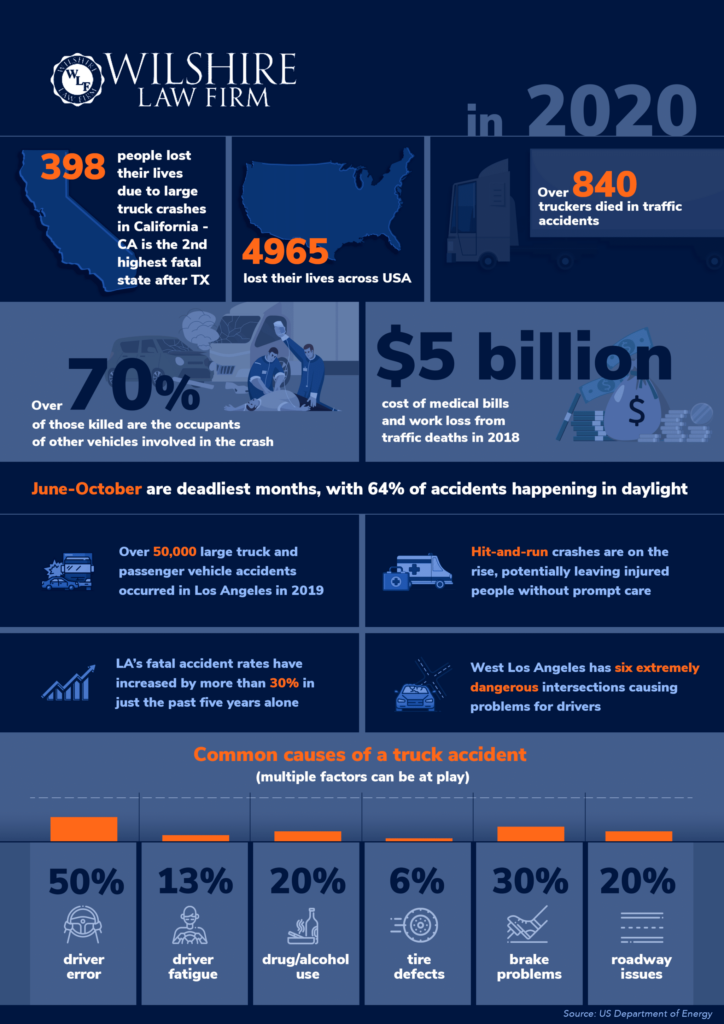Truck Crash Statistics: Understanding the Risks in 2022
Large trucks only make up 5% of the vehicles on the roadway [1]. They’re up to 30 times heavier than passenger vehicles, however, potentially resulting in serious damage and injury in an accident. If you’re going to share the road with these vehicles, it’s important to understand the risks, observe patterns of negligence, and be prepared to take legal action. Explore the leading truck accident statistics to see when accidents happen most often and why.Table of Contents
- Nevada Truck Accident Statistics
Examining Truck Accident Statistics
When you hear the term, ‘large truck,’ semi-trucks undoubtedly come to mind, especially ones fitted with nearly 60-foot trailers. These trucks deliver food and other goods all over the nation, filling stores with the items you want most. So, you likely see them whenever you hop on the highway, drive around town, and stop in at your favorite stores. They’re not the only large trucks on the road though. You also drive near tanker trucks tasked with delivering liquid goods, fire trucks on route to help with daily emergencies, and many other commercial vehicles. In fact, any commercial truck weighing over 10,000 pounds is a large truck and must abide by set laws for that vehicle classification. The restrictions get even tighter for trucks weighing 26,000 pounds or more [2]. When talking about truck accident statistics then, these 10,000+ pound vehicles are at the center of the conversation. The data takes time to compile though, so you need to look about five to ten years in the past to assess the risks. In 2020, current data revealed that large truck crashes went down by 10% from the prior year [3]. Overall, just over 105,000 large trucks nationwide got into a wreck that resulted in a minor to severe injury. Accidents resulting in fatalities decreased by 1%, totaling 4,965 deaths from large truck crashes in 2020. More than 70% of the time, the occupants of the other vehicles suffer fatal injuries. Large truck occupants make up 17% of the fatalities while the remaining 12% are bicyclists, pedestrians, and other non-occupants. Property damage-only crashes are less common in large trucks than in passenger cars. The high gross vehicle weight rating of the trucks usually results in at least minor injuries to the vehicle occupants.
High-Risk Times for Truck Accidents
Large truck accidents occur year-round, but the majority of the fatalities occur from June through October. At 483 fatalities total, October was the deadliest month in 2020 overall. The time of the day matters, too, with the majority of the accidents happening during the daytime. Only 36% of the crashes happened at night, likely due to the marked decrease in other drivers on the road after nightfall.Roadway Types Are Significant in Truck Crashes
The majority of large truck miles happen on the interstate as they ferry goods and more across the nation. Despite that, only 26% of their fatal accidents occur on the highways. City streets and other non-interstate roadways are much riskier to share with large trucks. When it comes to rural vs urban roadways, it’s only slightly riskier to drive near large trucks in rural areas. Fatal accidents occur on rural roads about 55% of the time with the remainder happening on urban roadways.Common Causes of Truck Accidents Statistics
As with all accidents, truck crash causes vary considerably. The most common reasons truck accidents occur include:Truck Driver Error
Even the best drivers can make grave errors while piloting large trucks. There’s not a lot of leeway either. Once the error occurs, it’s difficult to impossible to recover control of the truck and avoid an accident. The errors range from simply making the wrong moves due to roadway unfamiliarity to driving too fast for the conditions. Across all causes, driver error accounts for more than half of all large accidents.Trucker Fatigue
Large truck drivers often work long hours, which can lead to fatigue. When fatigue sets in, drivers are more likely to make serious errors or simply fall asleep behind the wheel. To decrease this risk, the Federal Motor Carrier Safety Administration (FMCSA) established Hours-of-Service regulations for truck drivers [4]. Despite that, fatigue still gets cited as a causative factor in 13% of accidents.Drug Use
Over-the-counter, prescription, and street drugs can alter mental function, potentially resulting in a crash. Alcohol greatly inhibits people’s ability to drive safely as well. Drug and alcohol use may impact perception, slow reaction times, or even cause the driver to fall asleep. About 20% of accidents note drug and alcohol use as a key factor in why the crash occurred.Tire Defects
Tire defects can quickly lead to vehicle instability, causing drivers of large trucks to lose control and crash. Tire pressure loss, tread separation, and full-on blowouts are the most common types of defects to occur. These issues cause large truck accidents about 6% of the time [5].Brake Problems
Brake problems result in vehicles being unable to fully stop in time, or even careening out of control. The brakes on large trucks could stop working correctly for a number of reasons, including leaking fluid lines, stuck calipers, and master cylinder failure. Brake issues are much more common than tire defects, showing up in large truck crash statistics nearly 30% of the time.Roadway Issues
Sometimes, the problem links back to the condition of the road, not the commercial truck. Large potholes, standing water, and missing signage and roadway markings all put truck drivers and their fellow drivers at risk. About 20% of large truck crashes occur, at least in part, due to problems with the roadway. Oftentimes, truck accidents result from multiple causes all leading up to a catastrophic incident. Trucks with old, worn tires, for example, can run into trouble upon hitting a pothole. Or drivers who are moving too fast for the conditions might suddenly experience brake or tire problems, resulting in a minor to severe accident.Commercial Truck Accident Statistics by Vehicle Type
Truck crash statistics vary by vehicle type as well. Since large trucks are any commercial vehicles over 10,000 pounds, all the following trucks fall under this umbrella.Semi Truck Accident Statistics
Semi trucks are widely known as tractor-trailers, 18-wheelers and big rigs. These large trucks carry heavy loads in their bulky trailers and single or double tanks. When fully loaded, these trucks need up to 40% more room to stop than cars do, especially on wet and slippery roadways [6]. Their long trailers make them difficult to maneuver as well. For that reason, they’re involved in the vast majority of large truck crashes resulting in fatal injuries. In 2020, 74% of the fatal large truck accidents involved tractor-trailers.Fire Truck Accident Statistics
Almost 200 people died in accidents involving emergency vehicles in 2020 [7]. Only a fraction of that figure involved fire trucks, however. Just over 10 fatal accidents involving fire trucks occurred while they were en route to an emergency with their lights and sirens in use. Nearly 20 more fatal crashes occurred while driving the fire trucks in between emergency events.Garbage Truck Accident Statistics
Garbage truck accidents occur quite often due to their large loads, stop-and-go driving behaviors, and need to maneuver in low-light conditions. In 2017, these trucks were involved in 107 crashes resulting in fatalities [8]. Beyond that, more than 1,400 additional injury-causing accidents occurred in the same time period. Sanitation workers only account for about 25% of serious or fatal injuries.Bus Accident Statistics
Throughout the school year, there are over 479,000 school buses on the roadway [9]. Public bus lines and private charter buses easily double that figure, resulting in thousands of bus accidents per year. School buses alone got into 4,800 crashes resulting in injuries in 2020. Furthermore, 54 people lost their lives in school bus-related accidents, most of whom were the occupants of the other vehicles.Forklifts & Fork Truck Accident Statistics
Forklifts weigh 9,000 pounds on average, but they can reach all the way up to 20,000 pounds. So, although they are not on the roadway, forklifts get into serious accidents on a regular basis as well. In 2020, these incidents resulted in more than 7,200 minor to serious injuries [10]. In addition, 78 people lost their lives due to forklift accidents. With so many different large trucks out there, you’re sure to share the road with these vehicles on a daily basis. Knowing the risks can help you stay safe, however, so keep your eye on large truck accident statistics year to year.California Truck Accident Statistics
- California had the second highest deaths from large truck crashes in 2020 [11].
- In 2020, large truck crashes resulted in 398 people losing their lives in California.
- The majority of the people killed in the accidents were occupants of the other vehicles.
- In 2018, the overall medical bill and work loss cost of traffic deaths hit over $5 billion
- California’s large truck accident rate has stayed fairly steady for the past five years.
Los Angeles Truck Accident Statistics
- Over 50,000 large truck and passenger vehicle accidents occurred in Los Angeles in 2019 [13].
- LA’s fatal accident rates have increased by more than 30% in just the past five years alone.
- Hit-and-run crashes are on the rise, potentially leaving injured people without prompt care.
- West Los Angeles has six extremely dangerous intersections causing problems for drivers.
- Defensive driving can help reduce the risk of getting into an accident while traveling through LA.
Additional Cities Reporting Significant Data
California has over 396,000 miles of roadway filled with large truck and passenger vehicle drivers trying to get to their destinations safely. The places with the highest risks of accidents are industrious, thriving communities, like the San Jose-Sunnyvale-Santa Clara area [14]. Centrally located cities, like Fresno, also show an elevated risk in both frequency and severity of large truck accidents.Nevada Truck Accident Statistics
- Nevada large truck and passenger vehicle drivers travel over 25 million miles every year [15].
- From 2015 to 2019, more than 650 people died in serious traffic accidents in Nevada [16].
- Around 10% of the traffic accident deaths occurred in accidents involving large trucks.
- Large trucks are involved in about 4% of injury-causing accidents across the state.
- Correctly wearing your seatbelt while driving defensively can reduce your risk of harm.
Las Vegas Truck Accident Statistics
- All the major highways running through Nevada all come together to converge in Las Vegas.
- Over 40% of traffic accidents in Nevada actually occur in the greater Las Vegas area [17].
- More than 22,200 crashes causing injuries or fatalities occur in the Las Vegas metro area daily.
- Large truck and passenger vehicle crashes result in at least one fatality every other day.
- The number of fatal accidents happening in the greater metro area is rising year after year.
Additional Cities Reporting Significant Data
Las Vegas drivers face the highest risk of getting into an accident involving large trucks and other vehicles. Other areas with notable crash rates also lie in Clark County, including Henderson and Paradise. Accident rates are lower on the highways running through the northern portion of the state.Frequently Asked Questions about Truck Accident Statistics
How many truckers died in 2020?
Over 840 truckers died in traffic accidents in 2020. There were 4,965 fatal accidents overall. Large truck drivers make up 17% of the fatalities in those wrecks. Crashes have been the number one cause of on-the-job truck driver deaths since 2012. Increasing seat belt usage can reduce fatal injuries in these accidents.Where do most truck accidents occur?
Large truck accidents occur most often on surface streets in city centers and suburban areas. Highways see the lowest rate of crashes, although the resulting injuries in the accidents that do happen are usually more severe. The states with the highest number of deaths from large truck accidents include Texas, California, and Florida.How common are trucking accidents?
Occurring at a rate of 105,000 per year or more, trucking accidents are quite common. The accident rate has decreased by 10% nationwide. Large truck crash statistics have stayed relatively steady in heavily populated states, like California. Large truck crashes happen most often in busy cityscapes vs open highways.What is the number one cause of truck accidents?
Driver error is the number one cause of truck accidents. More than half of all accidents have driver error as a contributing factor. Other possible causes include driver fatigue, drug and alcohol use, roadway defects, and issues with the truck’s brakes and tires. Oftentimes, more than one cause factors into the accident happening.Why are trucking accidents a serious issue?
Trucking accidents are a serious issue because the large trucks weigh up to 30 times more than passenger vehicles. Serious damage can occur as a result, including injuries causing lifelong disabilities or even death. With more than 105,000 large truck accidents happening per year, it just makes sense to try to decrease the crash rate any way possible.How many trucking accidents happen each year?
According to commercial truck accident statistics, more than 105,000 trucking accidents happen every year. Of those accidents, 4,965 resulted in fatal injuries, mainly to the occupants of the other vehicles. Large truck drivers account for about 17% of the crash fatalities. The types of large trucks involved in those crashes include tractor trailers, buses, garbage trucks, and fire trucks.Eligible for Compensation? File a Truck Accident Lawsuit
Even while driving defensively, there’s still a risk of getting into an accident with a large truck or commercial vehicle. Many of the causative factors may feel out of your control, including vehicle defects, roadway hazards, and driver error. But negligence on the part of the driver, manufacturer or trucking company may also play a role. When any accident with injuries occurs, the timeline is ticking. Your ability to file a lawsuit does expire in many states like California, within two years of the accident. Consider starting a free case review from an experienced truck accident law firm to obtain the justice and compensation you and your loved ones deserve.









